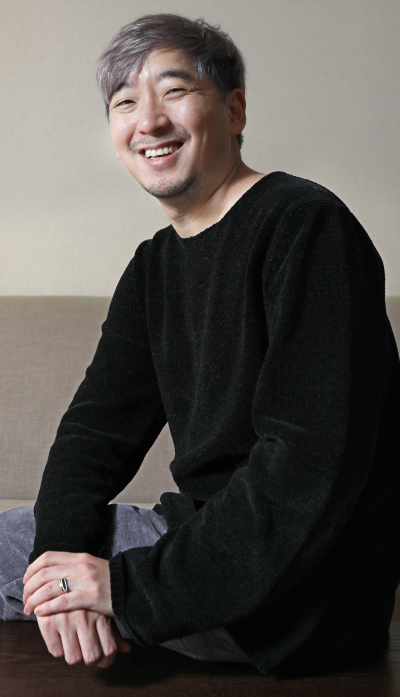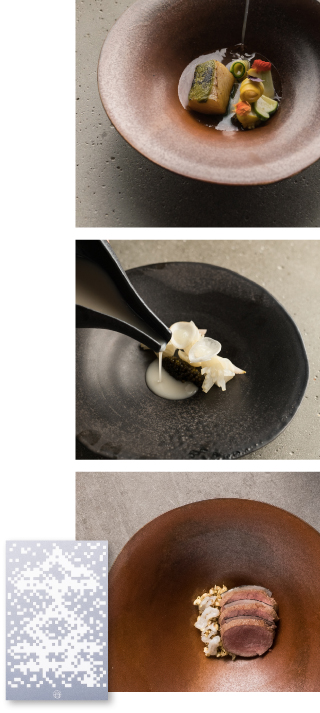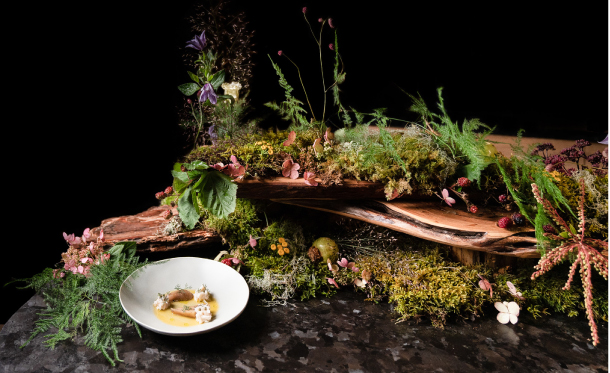Junghyun Park dreams up tomorrow’s hansik: Chef behind Atomix and Atoboy aims to create experiences

Chef Junghyun Park of New York restaurants Atomix and Atoboy poses for a photo during a recent visit to Korea. [PARK SANG-MOON]
Last month, Junghyun Park, the owner chef of Atomix, was nominated for the James Beard Award, often called the Oscars for chefs in the United States, for Best Chef in New York State.
Will all of these accolades, Korean chefs are inspired that they can also become hotshots in the culinary industry and work shoulder-to-shoulder with top chefs from around the globe thanks to the work of chef Park.
Junghyun Park worked in the kitchens of Jungsik in Seoul and New York before he opened Atoboy with his wife Ellia Park in 2016, just four years after they arrived in the city with $7,000 in their pocket two days after their wedding.
The more casual Atoboy served food inspired by Korea’s staple bansang, a collection of rice, soup and banchan (assorted small dishes). The more refined versions of the dishes are served at its sister restaurant Atomix, which opened in 2018. There, without a menu to look at before the food is served, diners get a detailed menu card accompanied with each dish. Terms like jjim (braised stew) or guk (soup) that are often used in Korean cooking are explained so that diners can get more familiar with the names of dishes in Korean. While the dishes may look like they are from Western cuisine, the restaurant explains what elements are inspired by Korean culture on each card.
“It is difficult to show the whole picture of Korean food culture through just one dish,” Park told the Korea JoongAng Daily during a visit to Korea recently, adding that Atoboy provides information in a friendly way, while Atomix gets more serious and provides more details.

1, 2, 4: Dishes served during the restaurant’s collaboration with Single Thread in California and a special display set up for the meal. 3: A dish served at Atomix in New York as well as a menu card given to diners with a detailed explanation of the dishes being served. [DIANE KANG]
Chef Park hopes to inspire people to make his restaurants one of the reasons they travel to New York. While catering to the tastes of New York, he has been educating himself on global trends by collaborating with a variety of talented chefs from around the world. Last year, he did about one collaboration event a month at both restaurants. He went to Europe to do events with London’s Lyle’s and others, and chefs from Denmark’s Relae came to New York as well. California’s three Michelin-starred Single Thread put together dishes in New York with Atomix as well.
“Mixing the ideas we have with the philosophies of others is what we pursue so that we can create something unique that’s only available for that particular event,” said Park. “The attention on Korean food in New York is bigger than ever and many different forms of Korean food are being enjoyed by a large range of people in the city, so the desire for some finer Korean also seems like it is growing steadily.”
The following are edited excerpts from an interview Chef Park recently had with the Korea JoongAng Daily.
Q. What style of Korean food is made at Atomix and Atoboy?
A. Atomix offers tomorrow’s edition of Korean food. Tteokbokki [spicy rice cakes], a popular Korean dish among the current generation, may not have been considered a type of Korean food during our grandparents’ generation. We need to think more about Korean food that will be more common in the future.
At Atoboy we serve hip and fun items, and at Atomix we take those things to do more diverse experiments. Based on the Korean foods we know, we add some ideas from Nordic cuisine, Chinese, Japanese and more, and such eclectic tastes in a more refined setting must have an appeal to many people.
Why do you continue to do collaborations with other restaurants around the world?
It is of course important to serve each dish we make to diners, but it is equally important for us to accumulate our own experiences through a variety of events. It is not about each restaurant bringing their signature dishes, because those dishes taste a lot better when consumed in the place that the dish was originally intended to be served at. We wanted to collaborate with restaurants that have different stories or images from our own, so that we can try making something new. Now people don’t choose restaurants simply based on photos of dishes they find online. That’s why we needed more stories and experiences that we can offer at the restaurants in order to [inspire more diners to actually come and see what’s different and fun.]
Which collaboration has particularly made an impact for you?
Personally, working with Relae in Denmark was the most fun for me. I have known the head chef there for a long time and we talk so much over a mobile messenger. Relae’s wok-fried crayfish was made with a version of XO sauce that we made instead of theirs. We also took a beetroot that they cook slowly and put it in bulgogi sauce (marinade used for thinly sliced beef) to make it more like hansik (Korean food). The taste of the dishes served may not have not been 100 percent [perfect], but I think the diners enjoyed the variation.
How much Korean liquor do you serve at your restaurant?
Both Atoboy and Atomix are centered on a wine program. On top of that, Atomix serves many cocktails because it has a bar. We don’t have too many [drinks] available, but we expect to see more as master sommelier Kim Kyung-moon is in the process of introducing more Korean drinks available in the United States. For now, it is more about bartenders offering a complimentary tasting of a base liquor in a cocktail to get diners curious about Korean drinks.
Will you continue doing the Korean chef series that you have done in the past years?
I introduced food by chefs from many different restaurants in Korea such as Zero Complex and Toc Toc as well as Gaon and Mosu last year. Aside from working with Korea-based chefs in New York, we plan to continue the series with many Korean restaurants across the United States, such as Hanok in Portland, Oregon, and Jeong in Chicago, to do a variety of events. We will continue working with Korean chefs based in cities outside of Korea, such as chef Sun Kim of Meta in Singapore.
Many chefs across the world are now interested in Korean-style fermentation. What are the things you find yourself delving into?
When you make doenjang (fermented soybean paste), there is a bacteria that makes the soybeans doenjang. We use that bacteria to ferment ingredients other than soybeans. We have done the process to make doenjang with carrots instead of beans, and that is basically carrot sauce. We want to see what items that have come from our research can really be applied to cook food at restaurants, and check how customers respond to these items or even other food companies. Another thing I want to focus more on is Korean-style dried ingredients.

[DIANE KANG]
I plan on opening a kitchen solely for research and development (R&D). There are certain things you can never learn unless you really get your hands on it and see what fails and what succeeds. If what you serve is a variation of recipes that are already in a cookbook, then you might not need that kind of R&D kitchen, but you need it if you want to create a menu that’s new. Trying different things to see what you are most interested in and what you can develop more in a research lab really pushes chefs to grow.
What’s your next project in terms of opening a new spot after Atoboy and Atomix?
We are preparing to open a lounge bar called Seoul Salon. This will be more like a gathering place with some food and drinks, just like the lobby of a hotel. People these days are more active online, so some are afraid of meeting people offline. There are places where a legendary writer is known to have worked in or drank in. I want this place to be an idea-creating spot. Things that you think are ridiculous can be talked about here, and those ideas can come true later on.
What makes you want to work on developing young talent?
Some restaurants last long and some do not. I listen to the needs of our team members, and try to set a vision from which they can stay a part of the team with me. We talk a lot about how everyone pictures their future. If they are interested in doing more charity work, then the team will either work with other foundations or maybe even internally make a program. We also help them get work permits or even a green card so that they can continue pursuing what they want to do in New York.
What is it like to have two Michelin stars?
Personally, it is so meaningful and I was so happy to learn the news. One star got me to a certain level, and two stars opened up another door. I want to build a restaurant where diners bring home [memorable] experiences. More chances may come because I can feel us getting more attention through incoming requests for interviews and events.
What’s your goal?
Since I was young, I have told my friends that I want to change the world. That world can be a small one or a big one. I don’t know how big of a change I can make and how big of an impact I can have, but at least to the people around me, to the diners that come to my restaurant, to the young chefs who desire my restaurant, or anyone who’s interested in hansik - I hope I can make some impact.
BY LEE SUN-MIN [summerlee@joongang.co.kr]










with the Korea JoongAng Daily
To write comments, please log in to one of the accounts.
Standards Board Policy (0/250자)